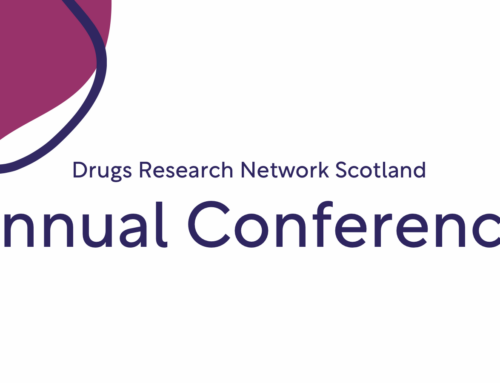Event report: IOTOD Conference 11-12 May 2022

Improving Outcomes in the Treatment of Opioid Dependence (IOTOD) is an educational initiative that aims to improve opioid dependence healthcare through a variety of programmes, such as the THN toolkit, reports, and other educational resources. As part of their education initiatives, IOTOD also run an annual conference, and this year Hazel @Team DRNS was delighted to be able to attend the 20th of these events. IOTOD is an organisation in which our very own co-convenors, Professor Catriona Matheson and Duncan Hill play an important role, and it was great to see them wear different hats over the two days of presentations and panel discussions. Joining them was a line-up of some key international names in the field. Below are highlights of the presentations that took place over the two days. You can find videos on demand on the IOTOD website.
Day 1
Patient profiles: past and present
Catriona Matheson set the tone of the event by introducing the changing demographics of the people using substances. Key was the topic of complexity in peoples’ lives. We were introduced to evidence which showed that people using drugs nowadays tend to be older than in previous decades, that polydrug use is more common, and that physical and mental comorbidities are increasingly important.
Adrian Dunlop spoke about gender disparities in drug use treatment. There are differences, he noted, in terms of the numbers of men and women in treatment, the perceived barriers for men and women accessing it, and the rates of attrition and success of treatment. He described the initiatives that were being used in his own practice to address the barriers for women in treatment but argued that more needed to be done to work in a trauma-informed way which recognises the specific challenges women face.
Stephen Walcher’s topic considered the increase in poly-drug use. He remarked that poly-drug use is now the norm and outlined the implications of this increase for people physiologically, psychologically, socially, and as they affect treatment. He said that for clinicians working with people who use drugs, a key task was to understand what motivates a person to use. “Addictions work”, he said, “is relationship work”.
Opioid analgesia dependence management: are we doing enough?
Cathryn Kemp described her experience of becoming dependent on painkillers which were initially prescribed for chronic pain. Since leaving rehab she has been a been a keen advocate of the changes needed to improve practice for people in her situation. She pointed people towards the Pain killer Addiction Information Network (PAIN).
Maurice Dematteis took as his starting point Cathryn’s experiences and invited the audience to consider what they might do in clinical practice to avoid prescribed opioid dependence in their patients. He asked clinicians to use a person-centred integrative therapeutic approach which considered holistically what patients themselves felt were problems e.g., sleep disturbance, pain management, etc and to consider wider non-medication treatment options.
The real-world experience of the buprenorphine implant – The Accord Healthcare and Molteni Farmaceutici sponsored satellite symposium
Michael Frost and Ken Lee spoke in detail about implantable buprenorphine; what it is, when to use it, the evidence supporting its use, and how to insert and remove it. The advantages of the implants were described as 1) the dose prescribed is the dose received, 2) it has a steady sustained release over 24 weeks, 3) the patient cannot take more than prescribed 4) the medication cannot be diverted, 5) it is convenient and results in reduced stigma for patient.
Seeing the whole patient: mental health and psychosocial treatments
Oscar D’Agnone started the session by talking about the complex co-morbid interrelation of mental ill-health and substance use. He encouraged practitioners to ask their patients routinely about their mental wellbeing and advocated integrative care approaches.
John Marsden spoke about work as an important protective factor for people that use drugs. He pointed delegates towards a study, currently underway, which is trialling the use of Individual Placement and Support (IPS) intervention. This is a rapid job search approach which has seen good results for people with poor mental wellbeing and physical disability and this study will investigate its efficacy for people who use drugs.
Duncan Cairns is an expert by experience, and he wanted to inspire delegates to ensure that their treatment plans were individualised and informed by their patient’s assessment of their treatment priorities and goals. Mindful of the complexity present in patients’ lives, Duncan used case studies to illustrate for some patients, the initial priority was often about helping them to feel safe, secure and stable first, before addressing substance concerns.
Indivior sponsored meet the expert session – Indivior
Duncan Hill talked to delegates about Buprenorphine/Naloxone sublingual tablets vs. film and shared the results of the small evaluation study which looked at efficacy and acceptability of film among patients in NHS Lanarkshire. It was helpful, he said, to have another treatment option for people who use drugs, and he suggested that there were many good reasons to use film with patients.
Day 2
A spotlight on ODT – what, when and why
Nick Lintzeris took the delegates through an “ODT 101” refresher session, explaining why and how opioid dependence treatment is used. He introduced delegates to the wide range of medication formulations and dosing, initiation, and tapering schedules. Useful in his section was the treatment algorithm found in Strang et al’s 2020 paper.
Michael Frost introduced the delegates to the range of buprenorphine formulations explaining, in particular, the patient and services advantages of long-acting buprenorphine injections. He noted that there was likely to be a buprenorphine formulation to suit most patients.
Duncan Hill referred to information presented earlier in the conference about the changing demographics of people who use drugs. Noting the increasing treatment complexity resulting from poly drug use, and the ageing population living with medicated comorbid conditions, he explained how important it was to consider drug-drug interactions and ran through some of the more common ones that clinicians need to consider.
Trish Hafford-Letchfield wanted delegates to consider the particular needs of older people who use substances, in particular how social workers could support substance use teams to address the age-specific barriers older people faced regarding accessing treatment. She referred to her recent co-authored paper which provided a systematic review of the interventions for this population.
A Camurus sponsored workshop about improving continuity of care for people in prison using Buvidal
Jake Hard, Bas Van den Berg and Deborah Iwanikow each presented their experiences of using long-acting buprenorphine (Buvidal) with prison populations in Wales, Belgium and France respectively. Each was encouraged by the efficacy and acceptability of the treatment for both patients and services, though in Belgium and France, the lack of access to this particular formulation of buprenorphine post-release proved problematic.
A Gilead supported session about viral hepatitis – uncovering the unknown
Graham Foster wanted the delegates to be aware of the changing WHO guidelines regarding the elimination of viral hepatitis C and the need to prove that this was being achieved. He noted that there would need to be substantial increase in testing, not only among traditional at-risk populations, but more widely. He noted the promising results emerging from the MINMON study which aimed to facilitate easier access to Hep-C treatment (also see: https://pubmed.ncbi.nlm.nih.gov/35026142/).
Heino Stöver expanded on Graham Foster’s point about wider testing, asking which populations at risk of blood borne viruses are currently overlooked. He said that in addition to the commonly considered populations which include people who inject drugs, sex workers, and men who have sex with men, services should increase their vigilance of people who engage with chemsex, those with alcohol use disorder and those using opioid painkillers. He wanted services to consider wider engagement and testing within these populations.
Ashley Brown talked about the challenge of managing Hep-B in services, noting that harm reduction approaches are very important, as is improved screening and treatment among the wider populations mentioned in Heino Stöver’s presentation.
A panel discussion talking about complex cases.
In this final session a panel of the presenters discussed complex cases which had been submitted by the delegates in advance of the conference.
At the event, a series of posters were also available to view, covering topics including medication assisted treatment in pregnancy, the importance of work activities as a treatment option, prevalence rates of blood-borne viruses, and the use of long-acting buprenorphine. These were complemented by the availability of sessions recorded during the IOTOD 2021 conference.
Thoughts from Hazel @Team DRNS
As expected, there were a number of very informative medication-focused sessions, but for me, with a background in mental health nursing, and as a former substance use worker with an interest in holistic care, I was particularly interested in the discussion of person-centred practice and the many physical, social, and mental wellbeing factors as they relate to substance use. As Prof Matheson noted in the first session of the first day, the contemporary lives of people using substances is ever more complex. This is something we explore further in our own DRNS annual conference “Complex lives and complex systems” on May 26, 2022.
This was a conference which placed evidence-informed practice centre-stage. At the end of each session, delegates were asked to vote for their key “commitment to change” i.e., what practitioners would commit to do differently in practice as a result of the session. I loved this way of inspiring action among the delegates. In addition, the use of case studies in some of the presentations was tremendously useful as a way to situate the learning in practice. It was also refreshing to hear lived-experience perspectives from Cathryn Kemp and Duncan Cairns. In the last few events I’ve attended, I’m seeing more representation from experts by experience. In my view such contributions offer a different perspective and are often very impactful. They encourage the audience to stay grounded, and to remind them why they do what they do.
Over to you. Getting away from your usual environment to attend events and connect with other people can be very inspiring. At this conference, delegates were asked if they would consider changing their practice as a result of the sessions they attended at IOTOD. It was encouraging to see how many did. Have you had a ‘lightbulb moment at a conference or training session which really changed the way you think or practice? What was it? I’m interested to hear what you think, so please feel free to sign up as a member so you can pop into the DRNS online forums and share your views.






